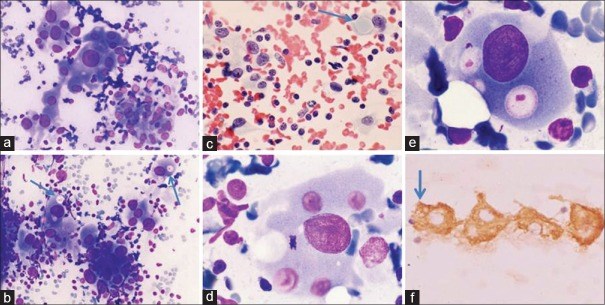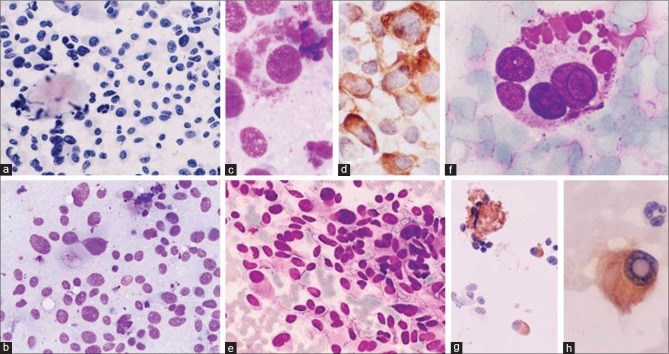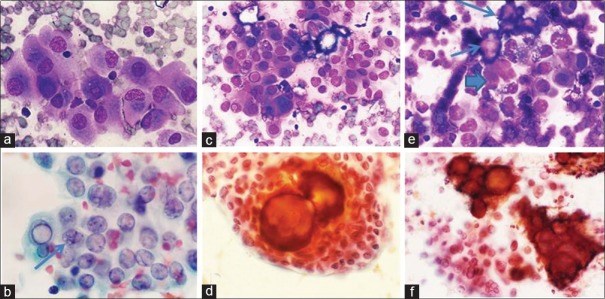Functional State of Cells During their Life and on their Journey Toward Inactivity and Death: Search for Morphological Evidence in Thyroid Fine Needle Aspiration Smears
Affiliations
Affiliations
- Department of Pathology, Faculty of Medicine, Kuwait University, and Cytology Unit, Mubarak Al-Kabeer Hospital, Kuwait.
Abstract
Synthesis and storage of thyroglobulin as well as synthesis of thyroid hormones and their release into the circulation are important functions of thyroid, which were studied in fine needle aspiration (FNA) smears from thyroid lesions. Evidence of thyroglobulin synthesis was demonstrated in neoplastic and nonneoplastic follicular cells, especially in Hürthle cells, in the form of colloid inclusions. Whereas the pinocytic vesicles containing colloid at the luminal end of in nonneoplastic and neoplastic follicular cells indicated engulfment of colloid for synthesis of thyroid hormones (T3 and T4), the marginal vacuoles (MVs) (fire-flare appearance) at the basal aspects of follicular cells suggested their release on way to the interfollicular capillaries. The morphological evidence of secretary activity could also be demonstrated in medullary thyroid carcinoma (MTC) in the form of azurophilic granules, marginal vacuoles, and intracytoplasmic lumina (ICL) with secretions; the secretory material, likely to be amyloid, present in MTC cells, and their release to the extracellular space was confirmed by positive immunocytochemical staining for calcitonin. It was found that nuclear grooves and related intranuclear cytoplasmic inclusions (INCIs) in papillary thyroid carcinoma (PTC) possibly represent an initial step of a degenerative process leading to formation of inactive cerebriform nuclei. Based on observation regarding formation and release of precursor substances for psammoma bodies (PBs), it was also suggested that PBs may not represent a process of dystrophic calcification over infarcted/dead papillae but suggest an active biological process, which leads to inhibition of growth of neoplastic cells and acts as a barrier against spread of PTC.
Keywords: Calcitonin; cerebriform nuclei; colloid inclusion; marginal vacuoles; nuclear grooves.
Conflict of interest statement
There are no conflicts of interest.
Figures
Similar articles
Das DK.Diagn Cytopathol. 2006 Apr;34(4):277-83. doi: 10.1002/dc.20416.PMID: 16544335
Das DK, Sharma PN.Anal Quant Cytol Histol. 2005 Apr;27(2):83-94.PMID: 15913201
Das DK.Diagn Cytopathol. 2005 May;32(5):264-8. doi: 10.1002/dc.20233.PMID: 15830362
Liu Y, Yuan L, Yang D, Jin Y.Diagn Cytopathol. 2018 Aug;46(8):690-693. doi: 10.1002/dc.23924. Epub 2018 Mar 10.PMID: 29524315 Review.
Das DK.Diagn Cytopathol. 2009 Jul;37(7):534-41. doi: 10.1002/dc.21081.PMID: 19373908 Review.
Cited by
Zhang Y, Mei F, He X, Ma J, Wang S.Front Endocrinol (Lausanne). 2022 Nov 8;13:1001477. doi: 10.3389/fendo.2022.1001477. eCollection 2022.PMID: 36425468 Free PMC article.
KMEL References
References
-
- Guyton RC. Human physiology and mechanisms of disease. 5th ed. Philadelphia: W. B. Saunders; 1992. The thyroid metabolic hormones; pp. 563–5.
-
- Capen CC. Anatomy: Comparative anatomy and physiology. In: Braverman LE, Utiger RD, editors. Werner and Ingbar's the thyroid: A fundamental and clinical text. 7th ed. Philadelphia: Lippincott-Raven; 1996. pp. 19–38.
-
- Das DK, Pathan SK, Francis IM, Sheikh ZA, Al-Juwaiser A, Shaheen A, et al. Cytoplasmic colloid inclusions in thyroid lesions: A cytomorphological study based on fine needle aspiration. Cytopathology. 2005;16:233–9. - PubMed
-
- Das DK. Marginal vacuoles (fire-flare appearance) in fine needle aspiration smears of thyroid lesions: Does it represent diffusing out of thyroid hormones at the base of follicular cells? Diagn Cytopathol. 2006;34:277–83. - PubMed
-
- Das DK, Mallik MK, George SS, Sheikh ZA, Pathan SK, Haji BE, et al. Secretory Activity in medullary thyroid carcinoma: A cytomorphological and immunocytochemical study. Diagn Cytopathol. 2007;35:329–37. - PubMed
-
- Mallik MK, Das DK, Mallik AA, Madda JP, Mirza K, Al-Bishi KK, et al. Dark and pale cerebriform nuclei in FNA smears of usual papillary thyroid carcinoma and its variants. Diagn Cytopathol. 2004;30:187–92. - PubMed
-
- Das DK, Mallik MK, Haji BE, Ahmed MS, Al-Shama’a M, Al-Ayadhy B, et al. Psammoma body and its precursors in papillary thyroid carcinoma: A study by fine-needle aspiration cytology. Diagn Cytopathol. 2004;31:380–6. - PubMed
-
- Das DK, Sheikh ZA, George SS, Al-Baquer T, Francis IM. Papillary thyroid carcinoma: Evidence of intracytoplasmic formation of precursor substance for classification and its release from well preserved neoplastic cells. Diagn Cytopathol. 2008;36:809–12. - PubMed
-
- Das DK. Psammoma body: A product of dystrophic calcification or of a biologically active process that aims at limiting the growth and spread of tumor? Diagn Cytopathol. 2009;37:534–41. - PubMed
-
- Begin LR, Allaire GS. Insular (poorly differentiated) carcinoma of the thyroid: An ultrastructural and immunocytochemical study of two cases. J Submicrosc Cytol Pathol. 1996;28:121–31. - PubMed
-
- Yang YJ, Khurana KK. Diagnostic utility of intracytoplasmic lumen and transgressing vessels in evaluation of Hürthe cell lesions by fine needle aspiration. Arch Pathol Lab Med. 2001;125:1031–5. - PubMed
-
- Maitra A. The endocrine system. In: Kumar V, Abbas AK, Aster JC, editors. Robbins and Cotran Pathologic Basis of Disease. South Asian Edition: Elsevier; 2015. pp. 1073–139.
-
- Das DK, Jain S, Tripathi RP, Parkash S, Khan IU, Rajwanshi A, et al. Marginal vacuoles in thyroid aspirates. Acta Cytol. 1998;42:1121–8. - PubMed
-
- Nilsson G. Marginal vacuoles in fine-needle aspiration biopsy smears of toxic goiters. Acta Pathol Microbiol Scand. 1972;80:289–93. - PubMed
-
- Buley ID. The thyroid gland. In: Gray W, editor. Diagnostic Cytopathology. Edinburgh: Churchill Livingstone; 1995. pp. 557–82.
-
- Ramzy I. 2nd ed. New York: McGraw-Hill; 2001. Clinical cytopathology and aspiration biopsy; p. 367.
-
- Söderström N, Telenius-Berg M, Akerman M. Diagnosis of medullary carcinoma of the thyroid by fine needle aspiration biopsy. Acta Med Scand. 1975;197:71–6. - PubMed
-
- Das DK, Gupta SK. Diagnosis of medullary carcinoma of thyroid. Role of fine needle aspiration biopsy. Bull PGI. 1980;14:86–9.
-
- Bose S, Kapila K, Verma K. A cytological, immune-cytochemical, and ultrastructural study. Diagn Cytopathol. 1992;8:28–32. - PubMed
-
- Green I, Ali SZ, Allen EA, Zakowski MF. A spectrum of cytopathologic variations in medullary thyroid carcinoma. Fine needle aspiration findings in 19 cases. Cancer. 1997;81:40–4. - PubMed
-
- Forrest CH, Frost FA, de Boer WB, Spagnolo DV, Whitaker D, Sterrett GF. Medullary carcinoma of the thyroid: Accuracy of diagnosis by fine needle aspiration cytology. Cancer Cytopathol. 1998;84:295–302. - PubMed
-
- Kinjo M, Yohena C, Kunishima N. Intracytoplasmic lumina in medullary carcinoma of the thyroid gland. Report of a case with cytologic and immunocytochemical features. Acta Cytol. 2003;47:663–7. - PubMed
-
- Kumar PV, Hodjati H, Monabati A, Talei A. Medullary thyroid carcinoma. Rare cytologic findings. Acta Cytol. 2000;44:181–4. - PubMed
-
- Paparaskeva K, Nagel H, Droese M. Cytologic diagnosis of medullary carcinoma of the thyroid gland. Diagn Cytopathol. 2000;22:351–8. - PubMed
-
- Parkin DM, Bray F, Ferlay J, Pisani P. Global Cancer Statistics, 2002. CA Cancer J Clin. 2005;55:74–108. - PubMed
-
- Prescott JD, Zeiger MA. The RET oncogene in papillary thyroid carcinoma. Cancer. 2015;121:2137–46. - PubMed
-
- Baloch ZW, LiVolsi VA, Asa SL, Rosai J, Merino MJ, Randolph G, et al. Diagnostic Terminology and Morphologic Criteria for Cytodiagnosis of Thyroid Lesions: A Synopsis of the National Cancer Institute Thyroid Fine Needle Aspiration State of the Science Conference. Diagn Cytopathol. 2008;36:425–37. - PubMed
-
- Yang GC, Liebeskind D, Messina AV. Diagnostic accuracy of follicular variant of papillary thyroid carcinoma in fine-needle aspirates processed by ultrafast Papanicolaou stain: Histologic follow up of 125 cases. Cancer. 2006;108:174–9. - PubMed
-
- Das DK, Mallik MK, Sharma P, Sheikh ZA, Mathew PA, Sheikh M. Papillary thyroid carcinoma and its variants in fine needle aspiration smears: A cytomorphologic study with special reference to tall cell variant. Acta Cytol. 2004;48:325–36. - PubMed
-
- Baloch ZW, LiVolsi VA. Cytologic and architectural mimics of papillary thyroid carcinoma. Diagnostic challenges in fine-needle aspiration and surgical pathology specimens. Am J Clin Pathol. 2006;125(Suppl):S135–44. - PubMed
-
- Albores-Saavedra J, Wu J. The many faces and mimics of papillary thyroid carcinoma. Endocr Pathol. 2006;17:1–18. - PubMed
-
- Oertel YC, Oertel JE. Diagnosis of malignant epithelial thyroid lesions: Fine needle aspiration and histopathologic correlation. Ann Diagn Pathol. 1998;2:377–400. - PubMed
-
- Das DK. Intranuclear cytoplasmic inclusions in fine-needle aspiration smears of papillary thyroid carcinoma: A study of its morphological forms, association with nuclear grooves, and mode of formation. Diagn Cytopathol. 2005;32:264–8. - PubMed
-
- Das DK, Sharma PN. Intranuclear cytoplasmic inclusions and nuclear grooves in fine needle aspiration smears of papillary thyroid carcinoma and its variants: Advantages of the count under an oil-immersion objective over a high-power objective. Anal Quant Cytol Histol. 2005;27:83–94. - PubMed
-
- Renshaw AA. “Histiocytoid” cells in fine-needle aspirations of papillary carcinoma of the thyroid: Frequency and significance of an under-recognized cytologic pattern. Cancer. 2002;96:240–3. - PubMed
-
- Akhtar M, Ali MA, Haq M, Bakry M. Fine-needle aspiration biopsy of papillary thyroid carcinoma: Cytologic, histologic, and ultrastructural correlations. Diagn Cytopathol. 1991;7:373–9. - PubMed
-
- Echeverria OM, Hernández-Pando R, Vázquez-Nin GH. Ultrastructural, cytochemical, and immunocytochemical study of nuclei and cytoskeleton of thyroid papillary carcinoma cells. Ultrastruct Pathol. 1998;22:185–97. - PubMed
-
- Fukushima T, Suzuki S, Mashiko M, Ohtake T, Endo Y, Takebayashi Y, et al. BRAF mutations in papillary carcinomas of the thyroid. Oncogene. 2003;22:6455–7. - PubMed
-
- Soares P, Trovisco V, Rocha AS, Lima J, Castro P, Preto A, et al. BRAF mutations and RET/PTC rearrangements are alternative events in the etiopathogenesis of PTC. Oncogene. 2003;22:4578–80. - PubMed
-
- Puxeddu E, Moretti S, Elisei R, Romei C, Pascucci R, Martinelli M, et al. BRAF (V599E) mutation is the leading genetic event in adult sporadic papillary thyroid carcinomas. J Clin Endocrinol Metab. 2004;89:2414–20. - PubMed
-
- Frattini M, Ferrario C, Bressan P, Balestra D, De Cecco L, Mondellini P, Bongarzone I, et al. Alternative mutations of BRAF, RET and NTRK1 are associated with similar but distinct gene expression patterns in papillary thyroid cancer. Oncogene. 2004;23:7436–40. - PubMed
-
- Bell CD, Coire C, Treger T, Volpe R, Baumal R, Fornaiser VL. The “dark nucleus” and disruption of follicular architecture: Possible new histological aids for the diagnosis of the follicular variant of papillary carcinoma of the thyroid. Histopathology. 2001;39:33–42. - PubMed
-
- Kini SR, Miller JM, Hamburger JI, Smith MJ. Cytopathology of the papillary carcinoma of the thyroid by fine needle aspiration. Acta Cytol. 1980;24:511–21. - PubMed
-
- LiVolsi VA. Philadelphia: WB Saunders Co; 1990. Surgical Pathology of the Thyroid; pp. 143–4. 158-63.
-
- TsuchidaT, Matsumoto M, Shirayama Y, Kasai H, Kawamoto K. Observation on psammoma bodies in cultured meningiomas: Analysis of three dimensional structures using scanning and transmission electron microscopy. Ultrastruct Pathol. 1996;20:241–7. - PubMed
-
- Kozlovskii OM, Iagubov AS, Kiparisov LN, Verbenko AA. Mechanism of formation of psammoma bodies in serous adenocarcinoma of the ovary. Arkh Patol. 1978;40:25–32. - PubMed
-
- Johannesen JV, Sobrinho-Simoes M. The origin and significance of thyroid psammoma bodies. Lab Invest. 1980;43:287–96. - PubMed
-
- Kubota T, Sato K, Yamamoto S, Hirano A. Ultrastructural study of the formation of formation of psammoma bodies in fibroblastic meningioma. J Neurosurg. 1984;60:512–7. - PubMed
-
- Ferenzy A, Talens M, Zoghby M, Hussain SS. Ultrastructural studies on the morphogenesis of psammoma bodies in ovarian serorus neoplasia. Cancer. 1977;39:2451–9. - PubMed
-
- Pelizo MR, Toniato A, Grigoletto R. Surgical treatment of papillary thyroid carcinoma: Uni- and multivariate analysis of prognostic factors (TNM staging system included) J Exp Clin Cancer Res. 1997;16:261–5. - PubMed
-
- Zidan J, Karen D, Stein M, Rosenblatt E, Basher W, Kuten A. Pure versus follicular variant of papillary thyroid carcinoma: Clinical features, prognostic factors, treatment, and survival. Cancer. 2003;97:1181–5. - PubMed
-
- Gyory F, Balazs G, Nagy EV, Juhasz F, Mezosi E, Szakall S, et al. Differentiated thyroid cancer and outcome in iodine deficiency. Eur J Surg Oncol. 2004;30:325–31. - PubMed
-
- Hawk WA, Hazard JB. The many appearances of papillary carcinoma of the thyroid. Cleve Clin Q. 1976;43:207–16. - PubMed
-
- Bocklage T, DiTamasso JP, Ramzy I, Ostrowski ML. Tall cell variant of papillary thyroid carcinoma: Cytologic features and differential diagnostic considerations. Diagn Cytopathol. 1997;17:25–9. - PubMed
-
- Das DK. Age of patients with papillary thyroid carcinoma: Is it a key factor in the development of variants? Gerontology. 2005;51:149–54. - PubMed





